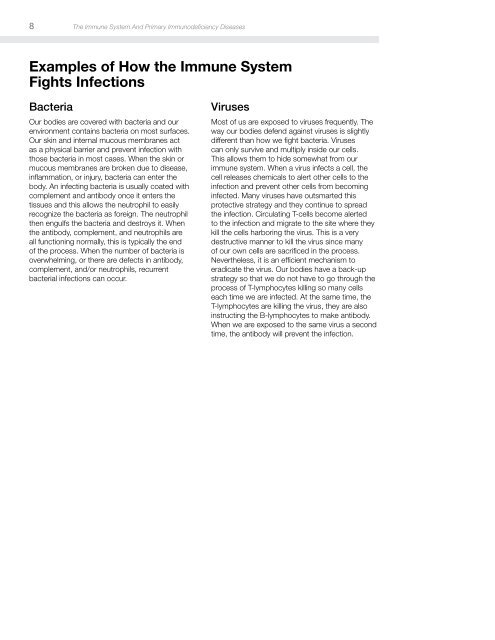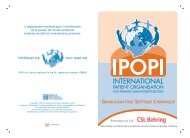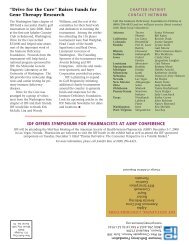IDF Patient & Family Handbook for Primary Immunodeficiency ... - IDFA
IDF Patient & Family Handbook for Primary Immunodeficiency ... - IDFA
IDF Patient & Family Handbook for Primary Immunodeficiency ... - IDFA
Create successful ePaper yourself
Turn your PDF publications into a flip-book with our unique Google optimized e-Paper software.
8 The Immune System And <strong>Primary</strong> <strong>Immunodeficiency</strong> Diseases<br />
Examples of How the Immune System<br />
Fights Infections<br />
Bacteria<br />
Our bodies are covered with bacteria and our<br />
environment contains bacteria on most surfaces.<br />
Our skin and internal mucous membranes act<br />
as a physical barrier and prevent infection with<br />
those bacteria in most cases. When the skin or<br />
mucous membranes are broken due to disease,<br />
inflammation, or injury, bacteria can enter the<br />
body. An infecting bacteria is usually coated with<br />
complement and antibody once it enters the<br />
tissues and this allows the neutrophil to easily<br />
recognize the bacteria as <strong>for</strong>eign. The neutrophil<br />
then engulfs the bacteria and destroys it. When<br />
the antibody, complement, and neutrophils are<br />
all functioning normally, this is typically the end<br />
of the process. When the number of bacteria is<br />
overwhelming, or there are defects in antibody,<br />
complement, and/or neutrophils, recurrent<br />
bacterial infections can occur.<br />
Viruses<br />
Most of us are exposed to viruses frequently. The<br />
way our bodies defend against viruses is slightly<br />
different than how we fight bacteria. Viruses<br />
can only survive and multiply inside our cells.<br />
This allows them to hide somewhat from our<br />
immune system. When a virus infects a cell, the<br />
cell releases chemicals to alert other cells to the<br />
infection and prevent other cells from becoming<br />
infected. Many viruses have outsmarted this<br />
protective strategy and they continue to spread<br />
the infection. Circulating T-cells become alerted<br />
to the infection and migrate to the site where they<br />
kill the cells harboring the virus. This is a very<br />
destructive manner to kill the virus since many<br />
of our own cells are sacrificed in the process.<br />
Nevertheless, it is an efficient mechanism to<br />
eradicate the virus. Our bodies have a back-up<br />
strategy so that we do not have to go through the<br />
process of T-lymphocytes killing so many cells<br />
each time we are infected. At the same time, the<br />
T-lymphocytes are killing the virus, they are also<br />
instructing the B-lymphocytes to make antibody.<br />
When we are exposed to the same virus a second<br />
time, the antibody will prevent the infection.
















